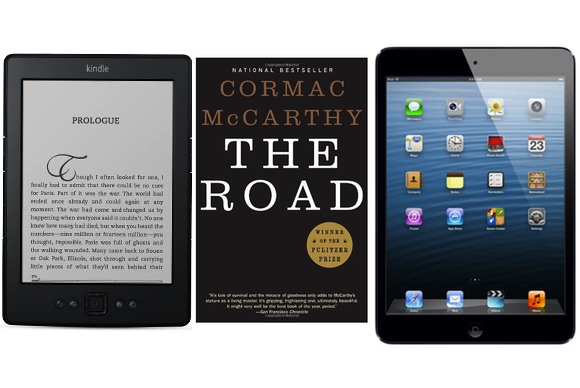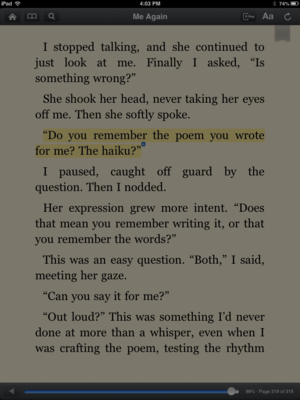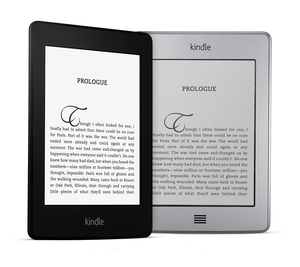
When the Kindle appeared, readers realized that years of false starts and empty promises were over, that the e-reading revolution had really and finally arrived. And then, a kind of Cold War set in between two kinds of readers: bibliophiles who insist that wood pulp—the musty smell of real paper!—is the best way to read, and the rest of us, who increasingly love the convenience of the digital ebook era.
They’re both right.
For the first time in history, when we sit down to read a book, we’re faced with more than simply a choice of what to read—we must also decide how to read it. Perhaps you've found your favorite reading method, and tend to stick with it. But the truth is that different mediums offer different strengths, which are in turn tuned to different types of reading. Wedging yourself into a corner with just one device for all types of reading can deny you the pleasures and advantages of the other.
In the last two years, I’ve read books in numerous ways: a desktop computer, a netbook, my iPhone, my iPad, an e-ink Kindle, and—believe it or not—a good old-fashioned paper book. (I even listened to Jonathan Franzen’s Freedom with the Audible.com iPhone app.) The strength of those first three options, in most cases, was that they’re available: If you need to read something now, they’ll do in a pinch.
Mostly, though, I stick to the iPad, a basic model e-ink Kindle, or paper. The iPad is the closest thing to my default reading device, for reasons I’ll get to in a second, but it’s never an automatic choice. Why? Because each has its advantages.
 |
| Note-taking on the Kindle app for iPad. |
This isn’t necessarily deep reading: The iPad facilitates note-taking and skimming—the kind of reading done by college students. But at the end of a book, it’s so much easier to go back, find your notes, and give yourself a Cliff’s Notes overview of what you just read. If you’re in information-processing mode, the iPad is usually the way to go. Making and navigating these sorts of notes on an e-ink Kindle is painful.
 |
| The Kindle |
The e-ink Kindle is also great for “lack of light” reading: Studies show that backlit displays, like the kind you get on the iPad and other tablets, reduce melatonin production and can disrupt your sleep—making the iPad or any other screen a bad idea for bedtime reading. If you're curling up with a story at night, this is often the best way to go.
Of course, “light” also has another meaning—the Kindle often offers the most ergonomically friendly version of a book, as well. When Robert Caro’s most recent volume about President Lyndon Johnson came out last year—weighing in at a hefty 736 pages—there was little temptation to buy that sucker in hardcover: My poor wrists would’ve rebelled, and my back was in no mood to carry it around in a bag everywhere. The iPad would’ve been a significant weight reduction, but I was also reading the book for pleasure instead of study. The even-lighter Kindle proved the ideal platform for such a monster.
Of course, the Kindle has lost some of its advantage on this front thanks to the advent of the iPad mini. On the other hand, the Kindle doesn’t offer easy access to Facebook or Twitter, either—and when I’m in a reading mood, the lack of electronic distraction the Kindle affords is welcome.
Of course, paper books don’t provide electronic distraction either. That’s why they’re often the best device, still, for old-fashioned immersive reading. The benefits here are admittedly less substantial, more theoretical and romantic, but I believe in them nonetheless. Paper books don’t require batteries. They don’t claim your attention with social media, games, or movies contained within. They simply are. And in the case of older books, those worn with time, one can feel oneself joining a lineage of readers. That’s not quite the case with today’s ebooks—though changes to the way used ebooks are traded and sold might someday endow those circuits and data with the romance of old-fashioned books. It hasn’t happened yet. Sometimes you want to read, stare out the window, read, then stare out the window. Books are still the best tool for that approach.
But is there a best best?
At this point, yes: The iPad mini. It’s got all the power of the iPad and its best reading apps; it features the ergonomic joy of the Kindle, and, well—if you want immersive reading free of distraction—you can always go ahead and turn your iPad to Airplane Mode to free yourself from distractions.
Otherwise, it’s OK to accept some messiness in your reading life. Don’t just download the next book on your reading list; consider how you want to experience it, and let that decision be your guide.
The secrets of how to make Incredible Video with your iPhone
Data source: Mcworld (By Joel Mathis)

No comments:
Post a Comment